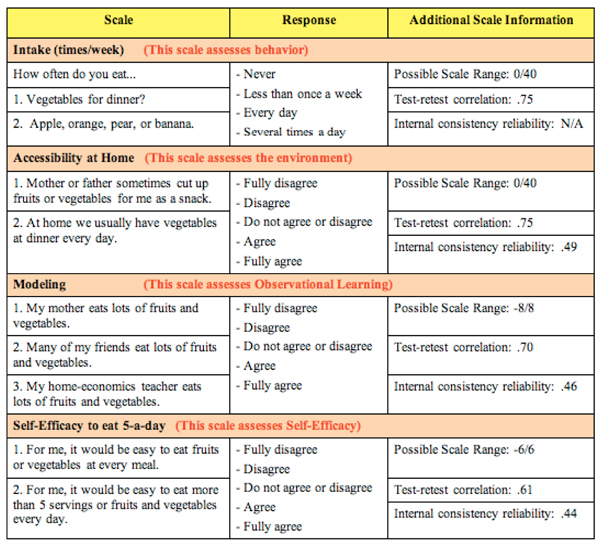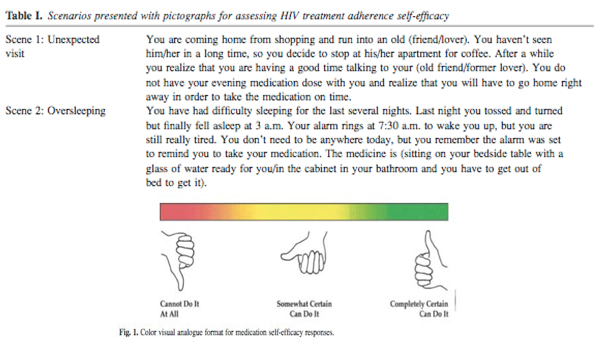This is an example of construct measurement from a study designed to identify predictors of future fruit and vegetable intake in Norwegian elementary school students. This is a good example of measuring and testing multiple constructs of SCT.
While reading through this example, pay extra attention to these areas:
- The constructs studied (highlighted in red).
- Test-retest correlation (Also called test-retest reliability - used to assess the consistency of a measure from one time to another. A higher correlation coefficient indicates greater reliability.)
- Internal consistency reliability (Used to assess the consistency of results across items within a scale. A higher Cronbach's alpha indicates greater consistency.)
Below are a sample of items from each scale.

Strengths:
- Researchers measured several constructs from SCT together, thus providing a more accurate view of behavior. Specifically, researchers examined:
Current behavior (intake)
- Environmental factors (accessibility at home and at school)
- Behavior of role models (observational learning of parents, teacher, friends)
- Self efficacy
- Reliability of measures were assessed by test-retest correlations and internal consistency reliability using Cronbach's alphas.
Limitations:
- Internal consistency reliability (Cronbach's alphas) were low for each subscale indicating that additional items may be needed in order to increase reliability coefficients.
- This study was done in Norway, which has a relatively homogenous population, compared to places like the United States. The validity of these items when applied to different populations should be considered and empirically tested.
Source: Bere, E, Klepp KI. Changes in accessibility and preferences predict children's future fruit and vegetable intake. International Journal of Behavioral Nutrition and Physical Activity 2005; 2:15.
In this study of individuals with spinal cord injuries, researchers defined self-efficacy as "one's confidence to plan and carry out physical activities and/or exercise based on their own volition".
Respondents indicated confidence using a 4-point rating scale:
| * 1 = not at all true |
* 2 = rarely true |
| * 3 = moderately true |
* 4 = always true |
Reliability testing indicated a high Cronbach's alpha (.93), meaning that the items are highly correlated and work well together in a scale.
Content validity, assessed with cognitive interviews and expert reviews, indicated a good fit with the construct of self-efficacy.
Construct validity was high, with all 10 items loading onto a single factor (called Spinal Cord Injury Exercise Self-Efficacy), explaining 60% of the variance.
Spinal Cord Injury Exercise Self-Efficacy Items: I am confident that:
- I can overcome barriers and challenges with regard to physical activity and exercise if I try hard enough.
- I can can find means and ways to be physically active and exercise.
- I can accomplish my physical activity and exercise goals that I set.
- When I am confronted with a barrier to physical activity or exercise I can find several solutions to overcome this barrier.
- That I can be physically active or exercise even when I am tired.
- That I can be physically active or exercise when when I am feeling depressed.
- That I can be physically active or exercise even without the support of my family or friends.
- That I can be physically active or exercise without the help of a therapist or trainer.
- That I can motivate myself to start being physically active or exercising again after I've stopped for a while.
- That I can be physically active or exercise even if I had no access to a gym, exercise, training, or rehabilitation facility.
This study examined medication adherence self-efficacy among low-literacy patients using a pictographic scale [10]. The scale used three scenarios and demonstrated good internal consistency reliability (a = .68) and test/retest reliability (r = .63). These kinds of pictographic scales may be especially useful in low-literate populations.


